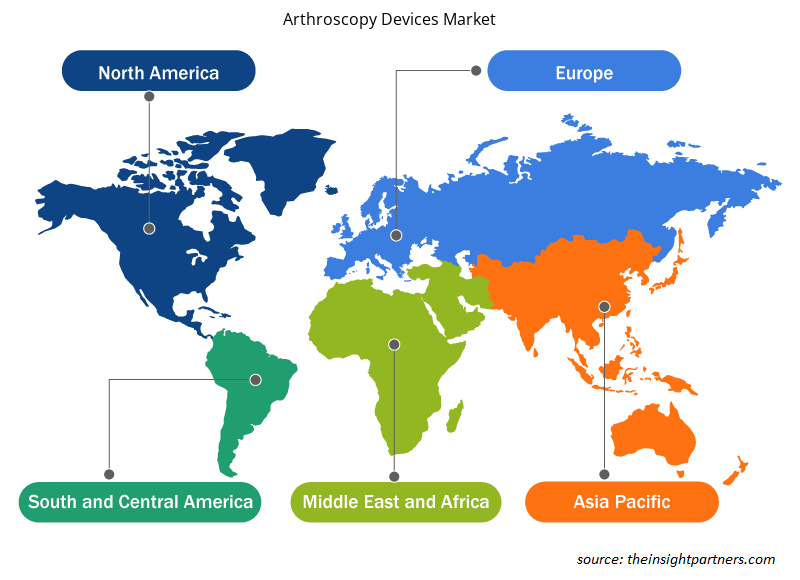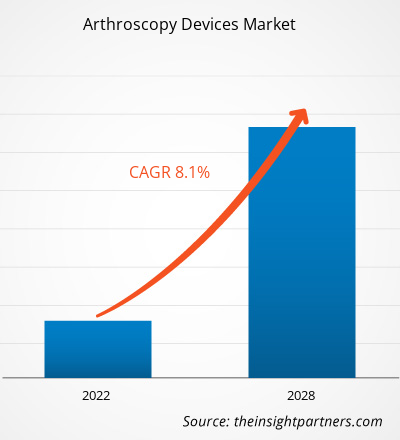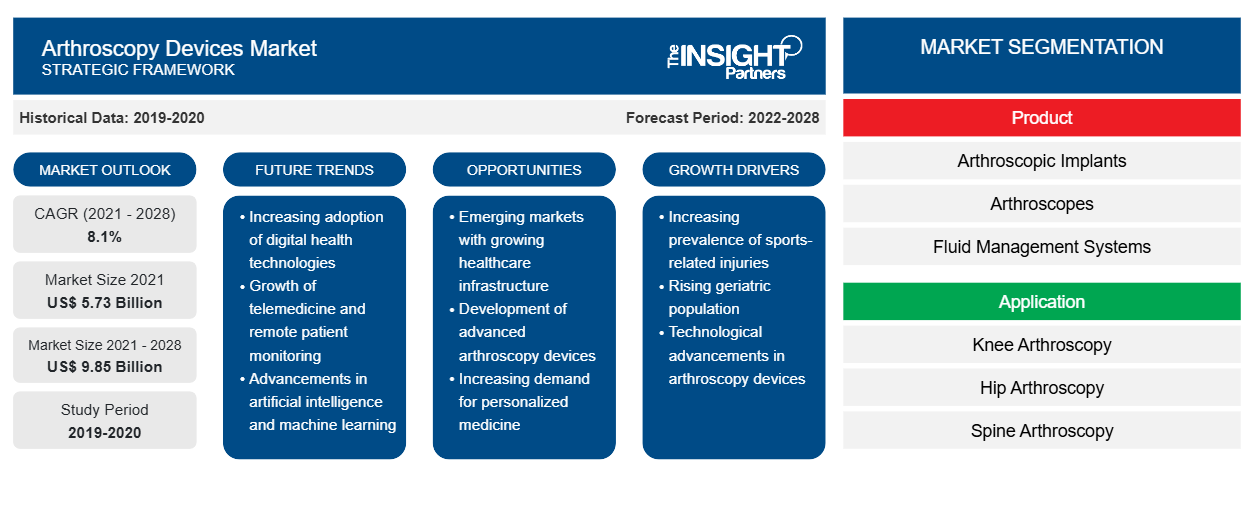Le marché des dispositifs d'arthroscopie devrait atteindre 9 853,88 millions USD d'ici 2028, contre 5 725,24 millions USD en 2021 ; il devrait enregistrer un TCAC de 8,1 % de 2021 à 2028. CAGR of 8.1% from 2021 to 2028.
L'arthroscopie est une procédure permettant de diagnostiquer et de traiter les problèmes articulaires. Un chirurgien insère un tube étroit relié à une caméra vidéo à fibre optique appelée arthroscope à travers une petite incision de la taille d'une boutonnière. Un arthroscope est un dispositif médical qui permet aux médecins de voir à l'intérieur des articulations du corps telles que le genou, la hanche, la colonne vertébrale, l'épaule et le coude pour inspecter, diagnostiquer et effectuer des procédures thérapeutiques. Les dispositifs d'arthroscopie peuvent examiner des maladies comme l'arthrose, la polyarthrite rhumatoïde, la tendinite et les tumeurs osseuses dans les articulations.
Le rapport offre des informations et une analyse approfondie du marché des dispositifs d'arthroscopie en mettant l'accent sur divers paramètres tels que les tendances du marché, les avancées technologiques et la dynamique du marché. Il fournit également l'analyse du paysage concurrentiel des principaux acteurs du marché mondial. En outre, il inclut l'impact de la pandémie de COVID-19 sur le marché dans toutes les régions. La pandémie de COVID-19 a créé à la fois une crise de santé publique et une crise économique dans le monde entier. Avant la pandémie, le marché mondial des dispositifs d'arthroscopie était en croissance constante grâce à des dépistages, des consolations et des traitements réguliers. La première vague de COVID-19 a perturbé les consultations, les suivis et les dépistages des cas oncologiques. La situation incontrôlée a été créée dans le secteur de la santé dans le monde entier, entraînant une réduction du nombre de consultations et un nombre réduit de cas d'arthrose et de polyarthrite rhumatoïde diagnostiqués. Plusieurs entreprises ont subi de lourdes pertes au cours du dernier trimestre de 2019 ; la pandémie a également eu une influence négative sur les premier et deuxième trimestres de 2020. Par conséquent, l'impact de la pandémie de COVID-19 sur le marché mondial a été immédiat et drastique. Les entreprises du monde entier ont été entravées par la perturbation de la chaîne d'approvisionnement et la demande accrue de produits et services de santé. Pour réduire l'infection par le COVID-19 dans les hôpitaux et les cliniques, les professionnels de la santé et les patients ont adopté et préféré le traitement des patients à distance. Dans ces circonstances imprévisibles, la pratique orthopédique n'a pas pu rester indemne. De nombreux traitements chirurgicaux et consultations non urgentes ont été annulés ou reportés. La chirurgie élective a été suspendue dans de nombreux établissements et le volume global des cas orthopédiques a chuté de façon spectaculaire afin de limiter la propagation du virus et de réserver et de réaffecter des ressources en personnel de santé (infirmières, anesthésistes), en équipement médical (équipement de protection individuelle, ventilateurs) et en lits. La stratégie de « rester à la maison » dans le monde a entraîné une réduction significative des chirurgies d'arthroplastie et d'arthroscopie, ainsi qu'une diminution de l'incidence des cas d'arthrose pendant la période COVID-19.oncological cases. The uncontrolled situation was created in the healthcare industry worldwide, led the reduced number of consultations and a smaller number of osteoarthritis and arthroplasty and arthroscopy surgeries, as well as a decrease in the incidence of osteoarthritis cases during the COVID-19 period.
Personnalisez ce rapport en fonction de vos besoins
Vous bénéficierez d'une personnalisation gratuite de n'importe quel rapport, y compris de certaines parties de ce rapport, d'une analyse au niveau des pays, d'un pack de données Excel, ainsi que de superbes offres et réductions pour les start-ups et les universités.
-
Obtenez les principales tendances clés du marché de ce rapport.Cet échantillon GRATUIT comprendra une analyse de données, allant des tendances du marché aux estimations et prévisions.
L'infrastructure des soins de santé ayant été perturbée en raison de l'épidémie de COVID-19, l'attention s'est portée sur le traitement de la maladie, et le diagnostic de diverses maladies a été négligé. En outre, la détection et le traitement des maladies musculo-squelettiques ont également été entravés par la pandémie de COVID-19. Cela a considérablement freiné la croissance du marché mondial des dispositifs d'arthroscopie.
Informations sur le marché
La prévalence croissante des troubles musculo-squelettiques devrait stimuler le marché
Les troubles musculo-squelettiques (TMS) sont les problèmes de santé les plus courants dans le monde. Selon les données publiées par l’Organisation mondiale de la santé (OMS), en février 2021, environ 1,71 milliard de personnes dans le monde souffraient de problèmes musculo-squelettiques. Les lombalgies sont une affection musculo-squelettique répandue, touchant 568 millions de personnes dans le monde. Les lombalgies sont la principale cause de handicap dans 160 pays. Les troubles musculo-squelettiques altèrent gravement la mobilité et la dextérité, entraînant un départ anticipé à la retraite, une diminution du bien-être et une diminution de la capacité à socialiser. Le nombre de personnes handicapées par des troubles musculo-squelettiques est en augmentation et cette tendance devrait se poursuivre au cours des prochaines décennies.MSDs) are the most common health conditions worldwide. According to the data published by the World Health Organization (WHO), in February 2021, approximately 1.71 billion individuals worldwide suffered from musculoskeletal problems. Lower back pain is a widespread musculoskeletal condition, affecting 568 million people worldwide. Lower back pain is the major cause of impairment in 160 countries. Musculoskeletal disorders severely impair mobility and dexterity, resulting in early retirement from work, decreased well-being, and diminished ability to socialize. The number of people disabled by musculoskeletal conditions has been growing, and this trend is expected to continue in the next decades.
Français De plus, selon l'OMS, les pays à revenu élevé sont les plus touchés en termes de population (441 millions), suivis des pays de la région du Pacifique occidental de l'OMS avec 427 millions, tandis que l'Asie du Sud-Est en compte 369 millions. Les maladies musculo-squelettiques sont également la principale cause d'années vécues avec incapacité (YLD) dans le monde, représentant environ 149 millions d'YLD, soit 17 % de toutes les YLD. Les fractures, qui touchent 436 millions de personnes dans le monde, l'arthrose (343 millions), d'autres blessures (305 millions), les douleurs cervicales (222 millions), les amputations (175 millions) et la polyarthrite rhumatoïde (14 millions) contribuent toutes à la charge globale des maladies musculo-squelettiques.YLDs) worldwide, accounting for roughly 149 million YLDs, or 17% of all YLDs. Fractures, which affect 436 million people worldwide, osteoarthritis (343 million), other injuries (305 million), neck pains (222 million), amputations (175 million), and rheumatoid arthritis (14 million) all contribute to the overall burden of musculoskeletal diseases.
L'arthroscopie chirurgicale est une option thérapeutique bien établie pour les personnes souffrant de douleurs et de dysfonctionnements articulaires chroniques. Par rapport aux procédures articulaires ouvertes, l'arthroscopie est moins invasive et entraîne de meilleurs résultats globaux pour les patients en termes de traitement des symptômes, de séjour à l'hôpital, de récupération structurelle et de résultats à long terme. Ainsi, la prévalence croissante des troubles musculo-squelettiques, de l'arthrose et de la polyarthrite rhumatoïde devrait stimuler le marché au cours de la période de prévision.
Informations basées sur les produits
En fonction du produit, le marché des dispositifs d'arthroscopie est segmenté en arthroscopes, implants arthroscopiques, systèmes de gestion des fluides , systèmes de radiofréquence, systèmes de visualisation, systèmes de rasoirs électriques et autres équipements arthroscopiques. En 2021, le segment des arthroscopes détenait la plus grande part du marché et devrait enregistrer le TCAC le plus rapide de 9,1 % au cours de la période de prévision. radiofrequency systems, visualization systems, powered shaver systems, and other arthroscopic equipment. In 2021, the arthroscopes segment held the largest share of the market and is expected to register the fastest CAGR of 9.1% during the forecast period.
Informations basées sur les applications
En fonction des applications, le marché des dispositifs d'arthroscopie est segmenté en arthroscopie du genou, arthroscopie de la hanche, arthroscopie de la colonne vertébrale, arthroscopie du pied et de la cheville, arthroscopie de l'épaule et du coude, etc. En 2021, le segment de l'arthroscopie de la hanche détenait la plus grande part du marché et devrait enregistrer le TCAC le plus élevé de 8,9 % au cours de la période 2021-2028.CAGR of 8.9% during 2021–2028.
Les acteurs du marché des dispositifs d'arthroscopie adoptent des stratégies organiques telles que le lancement et l'expansion de produits pour étendre leur empreinte et leur portefeuille de produits dans le monde entier et répondre aux demandes croissantes.
Par géographie
Sur la base de la géographie, le marché des dispositifs d'arthroscopie est segmenté en Amérique du Nord (États-Unis, Canada et Mexique), Europe (Royaume-Uni, Allemagne, France, Italie, Espagne et reste de l'Europe), Asie-Pacifique (Chine, Japon, Inde, Australie, Corée du Sud et reste de l'Asie-Pacifique), Moyen-Orient et Afrique (EAU, Arabie saoudite, Afrique du Sud et reste du Moyen-Orient et de l'Afrique) et Amérique du Sud et centrale (Brésil, Argentine et reste de l'Amérique du Sud et centrale).UAE, Saudi Arabia, South Africa, and the Rest of Middle East & Africa), and South & Central America (Brazil, Argentina, and the Rest of South & Central America).
Aperçu régional du marché des dispositifs d'arthroscopie
Les tendances régionales et les facteurs influençant le marché des dispositifs d’arthroscopie tout au long de la période de prévision ont été expliqués en détail par les analystes d’Insight Partners. Cette section traite également des segments et de la géographie du marché des dispositifs d’arthroscopie en Amérique du Nord, en Europe, en Asie-Pacifique, au Moyen-Orient et en Afrique, ainsi qu’en Amérique du Sud et en Amérique centrale.

- Obtenez les données régionales spécifiques au marché des dispositifs d'arthroscopie
Portée du rapport sur le marché des dispositifs d'arthroscopie
| Attribut de rapport | Détails |
|---|---|
| Taille du marché en 2021 | 5,73 milliards de dollars américains |
| Taille du marché d'ici 2028 | 9,85 milliards de dollars américains |
| Taux de croissance annuel moyen mondial (2021-2028) | 8,1% |
| Données historiques | 2019-2020 |
| Période de prévision | 2022-2028 |
| Segments couverts |
Par produit
|
| Régions et pays couverts |
Amérique du Nord
|
| Leaders du marché et profils d'entreprises clés |
|
Densité des acteurs du marché des dispositifs d'arthroscopie : comprendre son impact sur la dynamique commerciale
Le marché des dispositifs d'arthroscopie connaît une croissance rapide, tirée par la demande croissante des utilisateurs finaux en raison de facteurs tels que l'évolution des préférences des consommateurs, les avancées technologiques et une plus grande sensibilisation aux avantages du produit. À mesure que la demande augmente, les entreprises élargissent leurs offres, innovent pour répondre aux besoins des consommateurs et capitalisent sur les tendances émergentes, ce qui alimente davantage la croissance du marché.
La densité des acteurs du marché fait référence à la répartition des entreprises ou des sociétés opérant sur un marché ou un secteur particulier. Elle indique le nombre de concurrents (acteurs du marché) présents sur un marché donné par rapport à sa taille ou à sa valeur marchande totale.
Les principales entreprises opérant sur le marché des dispositifs d'arthroscopie sont :
- Arthrex, Inc.
- Société CONMED
- Johnson et Johnson Services, Inc.
- KARL STORZ SE & Co. KG
- Medtronic
Avis de non-responsabilité : les sociétés répertoriées ci-dessus ne sont pas classées dans un ordre particulier.

- Obtenez un aperçu des principaux acteurs du marché des dispositifs d'arthroscopie
Profils d'entreprise
- Arthrex, Inc.
- Société CONMED
- Johnson et Johnson Services, Inc.
- KARL STORZ SE & Co. KG
- Medtronic
- Richard Wolf SARL.
- Smith et Neveu
- Société Stryker
- Zimmer Biomet
- NuVasive, Inc.
- Analyse historique (2 ans), année de base, prévision (7 ans) avec TCAC
- Analyse PEST et SWOT
- Taille du marché Valeur / Volume - Mondial, Régional, Pays
- Industrie et paysage concurrentiel
- Ensemble de données Excel
Rapports récents
Témoignages
Raison d'acheter
- Prise de décision éclairée
- Compréhension de la dynamique du marché
- Analyse concurrentielle
- Connaissances clients
- Prévisions de marché
- Atténuation des risques
- Planification stratégique
- Justification des investissements
- Identification des marchés émergents
- Amélioration des stratégies marketing
- Amélioration de l'efficacité opérationnelle
- Alignement sur les tendances réglementaires























 Obtenez un échantillon gratuit pour - Marché des dispositifs d'arthroscopie
Obtenez un échantillon gratuit pour - Marché des dispositifs d'arthroscopie